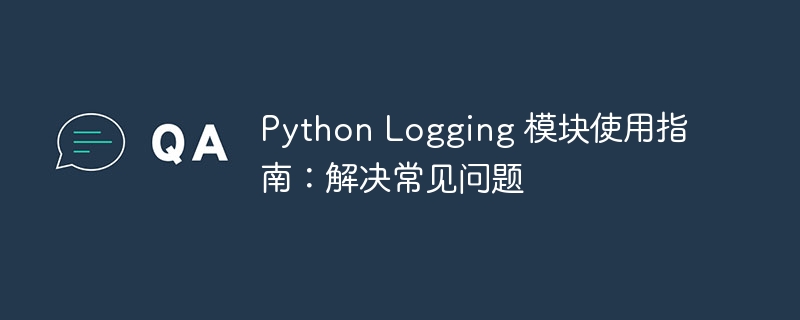Python Logging Module Usage Guide: Solving Common Problems

python Logging, recording, debugging, monitoring
Solution to common problems
1. How to set up basic configuration?
import logging # 设置基本配置 logging.basicConfig( level=logging.INFO, fORMat="%(asctime)s %(levelname)s: %(message)s" )
2. How to use different log levels?
logging.debug("这是一个调试消息")
logging.info("这是一个信息消息")
logging.warning("这是一个警告消息")
logging.error("这是一个错误消息")
logging.critical("这是一个严重错误消息")3. How to create a custom logger?
# 创建一个名为 "my_custom_logger" 的记录器
my_logger = logging.getLogger("my_custom_logger")
my_logger.setLevel(logging.INFO)
# 创建一个文件处理程序
file_handler = logging.FileHandler("my_app.log")
file_handler.setLevel(logging.INFO)
# 创建一个流处理程序
stream_handler = logging.StreamHandler()
stream_handler.setLevel(logging.INFO)
# 为记录器添加处理程序
my_logger.addHandler(file_handler)
my_logger.addHandler(stream_handler)
my_logger.info("这是一个自定义记录的消息")4. How to configure the log format?
logging.basicConfig( level=logging.INFO, format="[%(asctime)s] %(levelname)s %(name)s: %(message)s" )
5. How to use log filter?
# 创建一个过滤器,仅记录来自 "my_custom_logger" 记录器的警告消息 my_filter = logging.Filter() my_filter.filter = lambda record: record.name == "my_custom_logger" and record.levelno == logging.WARNING # 为记录器添加过滤器 my_logger.addFilter(my_filter)
6. How to catch unhandled exception?
import sys
# 为 unhandled 异常设置一个处理程序
logging.basicConfig(
level=logging.ERROR,
format="[%(asctime)s] %(levelname)s %(name)s: %(message)s",
handlers=[logging.StreamHandler(sys.stderr)]
)
# 触发一个 unhandled 异常
raise Exception("这是一个 unhandled 异常")7. How to enable thread-safe logging?
import logging
import threading
# 为 thread-safe 日志记录设置一个处理程序
logging.basicConfig(
level=logging.INFO,
format="[%(asctime)s] %(levelname)s %(name)s: %(message)s",
handlers=[logging.StreamHandler()],
concurrent=True
)
# 创建一个线程并记录消息
def my_thread():
logging.info("这是一个来自线程的消息")
# 启动线程
thread = threading.Thread(target=my_thread)
thread.start()
thread.join()8. How to configure the logging configuration file?
Create a file named "logging.conf" and place it in the application directory:
import logging.config
# 导入 logging 配置文件
logging.config.fileConfig("logging.conf")The above is the detailed content of Python Logging Module Usage Guide: Solving Common Problems. For more information, please follow other related articles on the PHP Chinese website!

Hot AI Tools

Undresser.AI Undress
AI-powered app for creating realistic nude photos

AI Clothes Remover
Online AI tool for removing clothes from photos.

Undress AI Tool
Undress images for free

Clothoff.io
AI clothes remover

AI Hentai Generator
Generate AI Hentai for free.

Hot Article

Hot Tools

Notepad++7.3.1
Easy-to-use and free code editor

SublimeText3 Chinese version
Chinese version, very easy to use

Zend Studio 13.0.1
Powerful PHP integrated development environment

Dreamweaver CS6
Visual web development tools

SublimeText3 Mac version
God-level code editing software (SublimeText3)

Hot Topics
 1369
1369
 52
52
 How to solve the permissions problem encountered when viewing Python version in Linux terminal?
Apr 01, 2025 pm 05:09 PM
How to solve the permissions problem encountered when viewing Python version in Linux terminal?
Apr 01, 2025 pm 05:09 PM
Solution to permission issues when viewing Python version in Linux terminal When you try to view Python version in Linux terminal, enter python...
 How Do I Use Beautiful Soup to Parse HTML?
Mar 10, 2025 pm 06:54 PM
How Do I Use Beautiful Soup to Parse HTML?
Mar 10, 2025 pm 06:54 PM
This article explains how to use Beautiful Soup, a Python library, to parse HTML. It details common methods like find(), find_all(), select(), and get_text() for data extraction, handling of diverse HTML structures and errors, and alternatives (Sel
 Mathematical Modules in Python: Statistics
Mar 09, 2025 am 11:40 AM
Mathematical Modules in Python: Statistics
Mar 09, 2025 am 11:40 AM
Python's statistics module provides powerful data statistical analysis capabilities to help us quickly understand the overall characteristics of data, such as biostatistics and business analysis. Instead of looking at data points one by one, just look at statistics such as mean or variance to discover trends and features in the original data that may be ignored, and compare large datasets more easily and effectively. This tutorial will explain how to calculate the mean and measure the degree of dispersion of the dataset. Unless otherwise stated, all functions in this module support the calculation of the mean() function instead of simply summing the average. Floating point numbers can also be used. import random import statistics from fracti
 How to Perform Deep Learning with TensorFlow or PyTorch?
Mar 10, 2025 pm 06:52 PM
How to Perform Deep Learning with TensorFlow or PyTorch?
Mar 10, 2025 pm 06:52 PM
This article compares TensorFlow and PyTorch for deep learning. It details the steps involved: data preparation, model building, training, evaluation, and deployment. Key differences between the frameworks, particularly regarding computational grap
 What are some popular Python libraries and their uses?
Mar 21, 2025 pm 06:46 PM
What are some popular Python libraries and their uses?
Mar 21, 2025 pm 06:46 PM
The article discusses popular Python libraries like NumPy, Pandas, Matplotlib, Scikit-learn, TensorFlow, Django, Flask, and Requests, detailing their uses in scientific computing, data analysis, visualization, machine learning, web development, and H
 How to Create Command-Line Interfaces (CLIs) with Python?
Mar 10, 2025 pm 06:48 PM
How to Create Command-Line Interfaces (CLIs) with Python?
Mar 10, 2025 pm 06:48 PM
This article guides Python developers on building command-line interfaces (CLIs). It details using libraries like typer, click, and argparse, emphasizing input/output handling, and promoting user-friendly design patterns for improved CLI usability.
 How to efficiently copy the entire column of one DataFrame into another DataFrame with different structures in Python?
Apr 01, 2025 pm 11:15 PM
How to efficiently copy the entire column of one DataFrame into another DataFrame with different structures in Python?
Apr 01, 2025 pm 11:15 PM
When using Python's pandas library, how to copy whole columns between two DataFrames with different structures is a common problem. Suppose we have two Dats...
 Explain the purpose of virtual environments in Python.
Mar 19, 2025 pm 02:27 PM
Explain the purpose of virtual environments in Python.
Mar 19, 2025 pm 02:27 PM
The article discusses the role of virtual environments in Python, focusing on managing project dependencies and avoiding conflicts. It details their creation, activation, and benefits in improving project management and reducing dependency issues.




